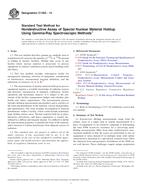Potřebujeme váš souhlas k využití jednotlivých dat, aby se vám mimo jiné mohly ukazovat informace týkající se vašich zájmů. Souhlas udělíte kliknutím na tlačítko „OK“.
ASTM C1455-14
Standard Test Method for Nondestructive Assay of Special Nuclear Material Holdup Using Gamma-Ray Spectroscopic Methods
Automaticky přeložený název:
Standardní zkušební metoda pro nedestruktivní testu Speciální jaderného materiálu přepadení pomocí gama spektroskopických metod
NORMA vydána dne 1.1.2014
Informace o normě:
Označení normy: ASTM C1455-14
Poznámka: NEPLATNÁ
Datum vydání normy: 1.1.2014
Kód zboží: NS-11358
Počet stran: 9
Přibližná hmotnost: 27 g (0.06 liber)
Země: Americká technická norma
Kategorie: Technické normy ASTM
Anotace textu normy ASTM C1455-14 :
Keywords:
holdup, holdup measurements, in-process inventory, material holdup, nuclear material holdup, ICS Number Code 27.120.30 (Fissile materials and nuclear fuel technology)
Doplňující informace
| Significance and Use | ||||||
|
5.1 Measurement results from this test method assists in demonstrating regulatory compliance in such areas as safeguards SNM inventory control, criticality control, waste disposal, and decontamination and decommissioning (D&D). This test method can apply to the measurement of holdup in process equipment or discrete items whose gamma-ray absorption properties may be measured or estimated. This method may be adequate to accurately measure items with complex distributions of radioactive and attenuating material, however, the results are subject to larger measurement uncertainties than measurements of less complex distributions of radioactive material. 5.2 Scan—A scan is used to provide a qualitative indication of the extent, location, and the relative quantity of holdup. It can be used to plan or supplement the quantitative measurements. 5.3 Nuclide Mapping—Nuclide mapping measures the relative isotopic composition of the holdup at specific locations. It can also be used to detect the presence of radionuclides that emit radiation which could interfere with the assay. Nuclide mapping is best performed using a high resolution detector (such as HPGe) for best nuclide and interference detection. If the holdup is not isotopically homogeneous at the measurement location, that measured isotopic composition will not be a reliable estimate of the bulk isotopic composition. 5.4 Quantitative Measurements—These measurements result in quantification of the mass of the measured nuclides in the holdup. They include all the corrections, such as attenuation, and descriptive information, such as isotopic composition, that are available 5.4.1 High quality results require detailed knowledge of radiation sources and detectors, transmission of radiation, calibration, facility operations and error analysis. Judicious use of subject matter experts is required (Guide C1490). 5.5 Holdup Monitoring—Periodic re-measurement of holdup at a defined point using the same technique and assumptions can be used to detect or track relative changes in the holdup quantity at that point over time. Either a qualitative or a quantitative method can be used. 5.6 Indirect Measurements—Quantity of a radionuclide can be determined by measurement of a daughter radionuclide or of a second radionuclide if the ratio of the abundances of the two radionuclides is known and secular equilibrium (Terminology C1673) is present. This can be used when there are interfering gamma rays or when the parent radionuclide does not have a sufficiently strong gamma-ray signal to be readily measured. If this method is employed, it is important that the ratio of the two radionuclides be known with sufficient accuracy to meet assay uncertainty goals. 5.7 Mathematical Modeling—Modeling is an aid in the evaluation of complex measurement situations. Measurement data are used with a mathematical model describing the physical location of equipment and materials. 1.1 This test method describes gamma-ray methods used to nondestructively measure the quantity of 235U or 239Pu present as holdup in nuclear facilities. Holdup may occur in any facility where nuclear material is processed, in process equipment, in exhaust ventilation systems and in building walls and floors. 1.2 This test method includes information useful for management, planning, selection of equipment, consideration of interferences, measurement program definition, and the utilization of resources (1, 2, 3, 4) .2 1.3 The measurement of nuclear material hold up in process equipment requires a scientific knowledge of radiation sources and detectors, transmission of radiation, calibration, facility operations and uncertainty analysis. It is subject to the constraints of the facility, management, budget, and schedule; plus health and safety requirements. The measurement process includes defining measurement uncertainties and is sensitive to the form and distribution of the material, various backgrounds, and interferences. The work includes investigation of material distributions within a facility, which could include potentially large holdup surface areas. Nuclear material held up in pipes, ductwork, gloveboxes, and heavy equipment, is usually distributed in a diffuse and irregular manner. It is difficult to define the measurement geometry, to identify the form of the material, and to measure it without interference from adjacent sources of radiation. 1.4 This standard does not purport to address all of the safety concerns, if any, associated with its use. It is the responsibility of the user of this standard to establish appropriate safety and health practices and determine the applicability of regulatory limitations prior to use. |
||||||
| 2. Referenced Documents | ||||||
|
Odebírejte informace o nově vydaných normách ZDARMA:
Chcete pravidelně odebírat informace o nově vycházejících normách z celého světa a to zcela zdarma?
Přihlašte se k odběru. Vše je velice jednoduché a absolutně ZDARMA.
Na výběr máte vydavatele z celého světa.




 Cookies
Cookies
